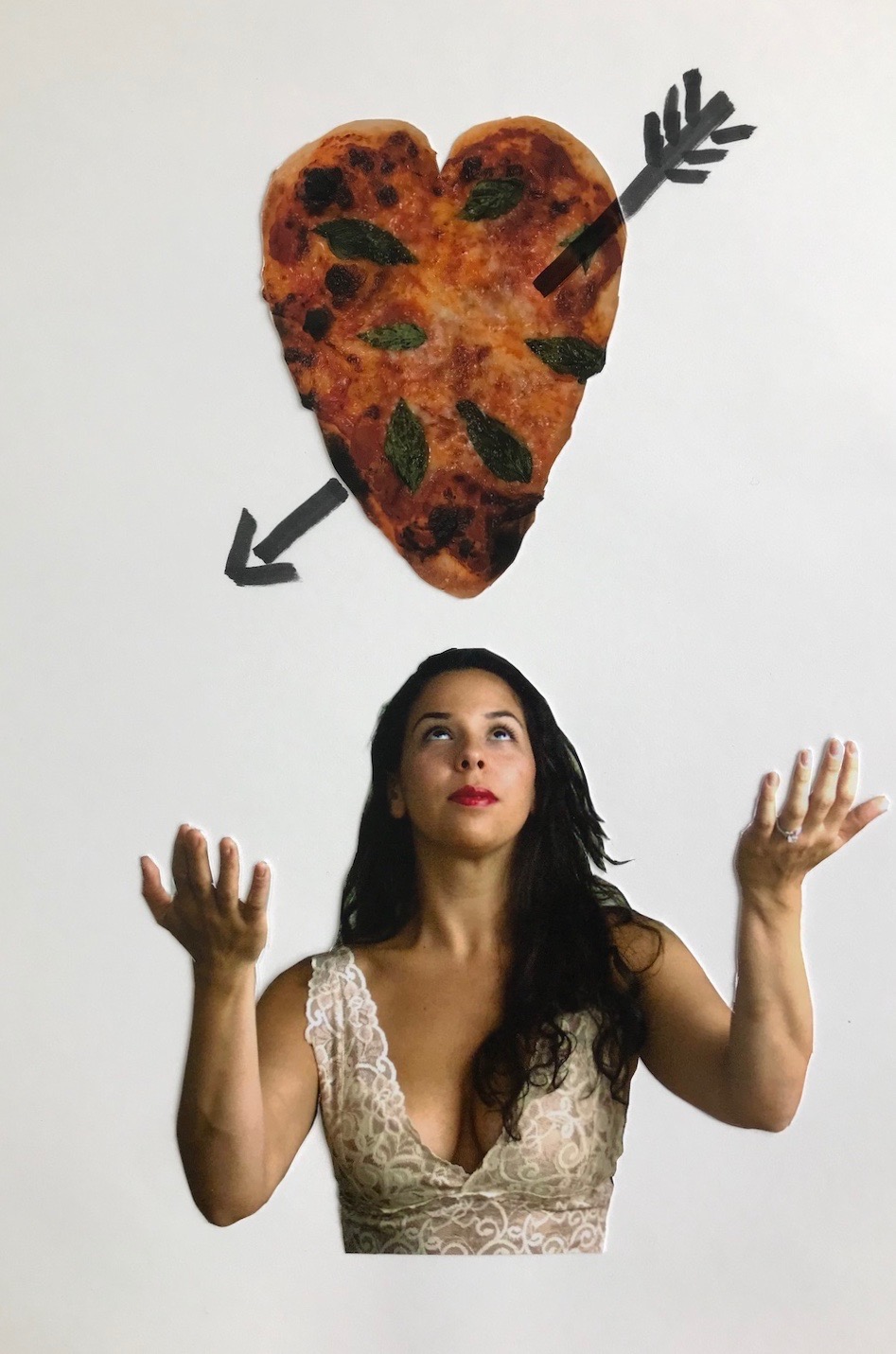MARIANI’S
Virtual
Gourmet
April 19, 2020
NEWSLETTER
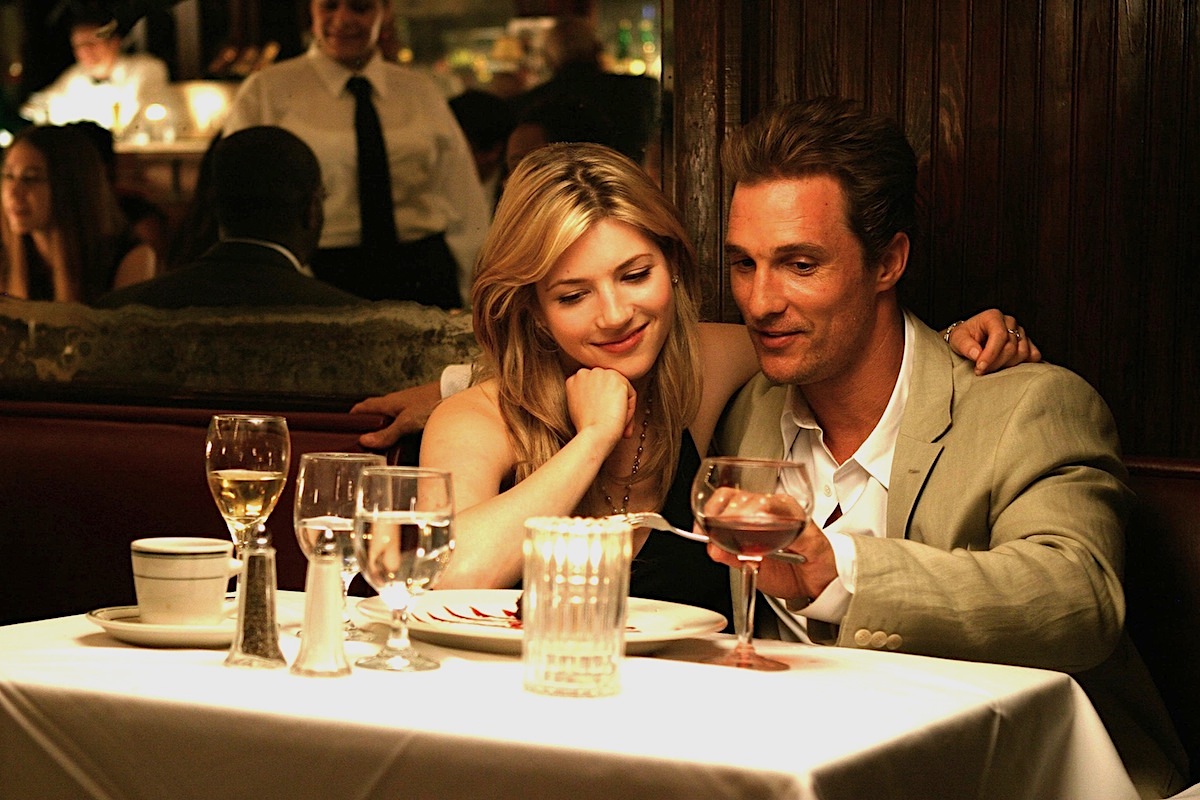
❖❖❖
IN THIS ISSUE
THIS WEEK
How the Give and Take from
Everyone Everywhere
Made American Gastronomy
the Most Diverse in the World
By John Mariani
NEW YORK CORNER
LOVE AND PIZZA
Chapter Four
By John Mariani
NOTES FROM THE WINE CELLAR
The Best Restaurants Are Selling and
Delivering Their Best Wines at Discount Prices
By John Mariani
❖❖❖
How the Give and Take
from Everyone Everywhere
Made American Gastronomy
the Most Diverse in the World
By John Mariani
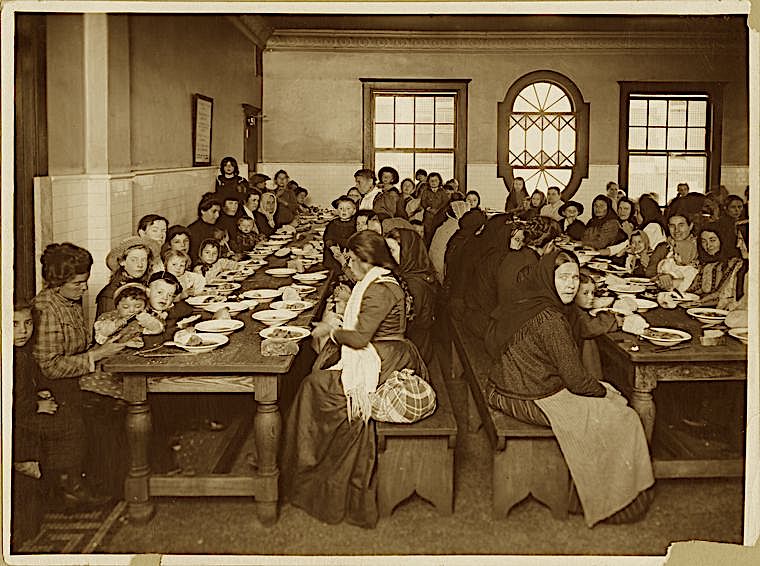
It
is too facile simply to say that all people
are immigrants from somewhere, but in the case
of North America, everyone had
to get here from somewhere else, and everyone
brought with them their own
culture, all of it eventually suffused
throughout the American continent,
giving us all the richest cornucopia of foods of
any country in the world.
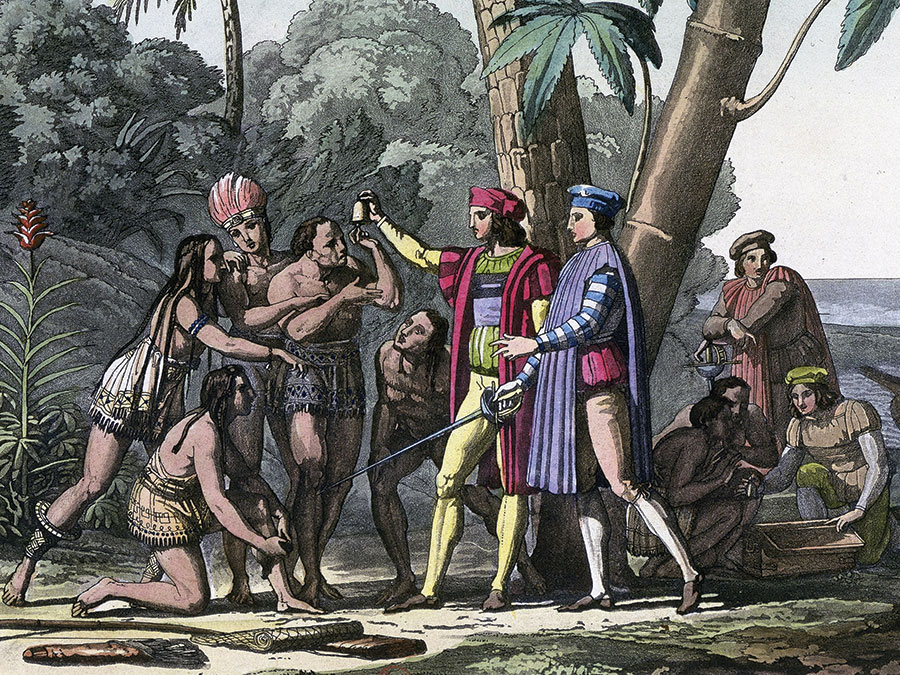 The first
immigrants came at least 15,000 years
ago. But it was not until Christopher Columbus’s
arrival in 1492 that the
Eastern and Western hemispheres collided
gastronomically in a titanic event to
be called the “Columbian Exchange.” The Genoese
explorer had specifically been
hunting for a spice route to the Orient—spices
then being worth their weight in
gold for Europeans who craved them—but instead
Columbus found a new world with
foods like potatoes, tomatoes, corn, cacao, sweet
and hot peppers, beans and
strawberries, all of them shipped back to Europe,
where people were astonished
by these wholly unknown foods.
The first
immigrants came at least 15,000 years
ago. But it was not until Christopher Columbus’s
arrival in 1492 that the
Eastern and Western hemispheres collided
gastronomically in a titanic event to
be called the “Columbian Exchange.” The Genoese
explorer had specifically been
hunting for a spice route to the Orient—spices
then being worth their weight in
gold for Europeans who craved them—but instead
Columbus found a new world with
foods like potatoes, tomatoes, corn, cacao, sweet
and hot peppers, beans and
strawberries, all of them shipped back to Europe,
where people were astonished
by these wholly unknown foods.
Imagine Italian food without
the tomato, Irish
food without the potato, Indian, Thai, and Chinese
food without the chile
pepper. And no chocolate anywhere but in Mexico.
Now consider that the
Columbian Exchange brought to America
wheat,
coffee beans, chickens, domesticated ducks,
cattle, bees, pheasants and
dozens of fruits and vegetables like artichokes,
carrots, yams, eggplant,
garlic, olives, lemons, apples, pears, rice and
tea. Imagine the American prairie
with millions of buffalo but no wheat fields
waving, Ohio and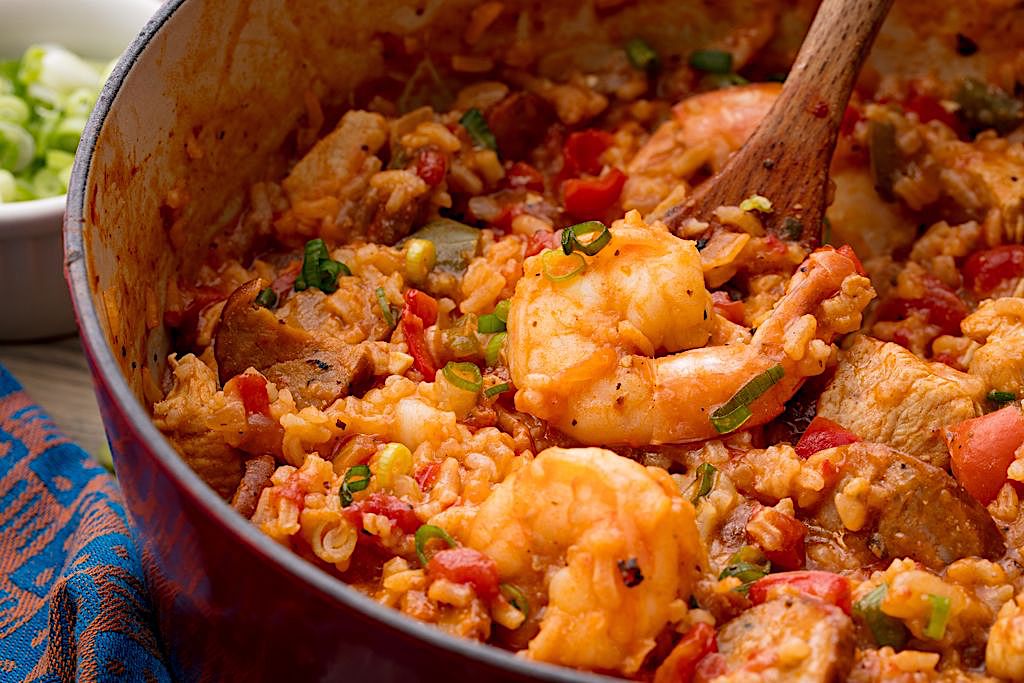 New York with no
apple orchards, the Hudson River once teeming with
sturgeon but the Hudson
Valley devoid of wineries, the Carolinas without
rice paddies. Such was the
radical transformation of gastronomy on both sides
of the world, and it caused
empires to grow and nations to go to war over
American plantations.
New York with no
apple orchards, the Hudson River once teeming with
sturgeon but the Hudson
Valley devoid of wineries, the Carolinas without
rice paddies. Such was the
radical transformation of gastronomy on both sides
of the world, and it caused
empires to grow and nations to go to war over
American plantations.
From every immigrant culture
came new foods and
new ways to cook it: pigs brought by the English
to the earliest colonies were
now roasted as barbecue; the Germans who settled
in the Midwest in the early
19th century grew hops to make beer, the Spanish
grapes to make wine. Africans
taken as slaves brought their yams and ground
nuts, which became important crops in
the South. French Huguenots who emigrated to
Louisiana from Acadia in 1755
adapted their native dishes to become chile-spiked
Cajun jambalaya (right)
and crawfish
boils.
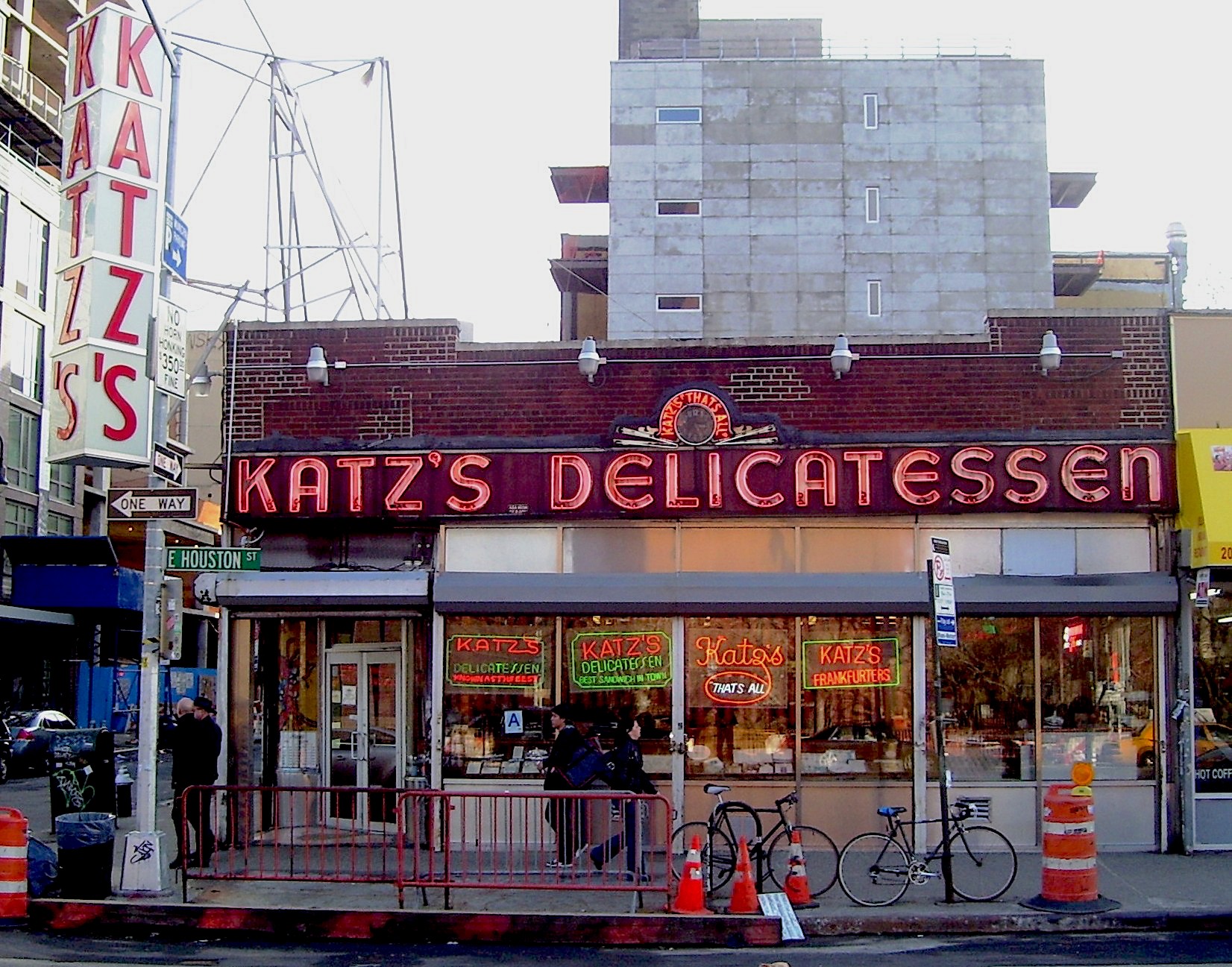 The
streets were not paved with gold but with
food markets, so the new arrivals often could
spend less money for much more
food in greater variety than in their home
countries. Also, their practical
need to adapt to their new world, coupled with a
deep nostalgia that caused
them to cling to the old, required using the
former to satisfy the latter.
Italian- or German- or Chinese-American, even
Tex-Mex cuisines, were all
filtered through memory but made by necessity with
what was available. Hunger
may have driven them to America, but the ability
of the immigrants to adapt
helped them prosper and feed their families in
ways unimaginable before.
The
streets were not paved with gold but with
food markets, so the new arrivals often could
spend less money for much more
food in greater variety than in their home
countries. Also, their practical
need to adapt to their new world, coupled with a
deep nostalgia that caused
them to cling to the old, required using the
former to satisfy the latter.
Italian- or German- or Chinese-American, even
Tex-Mex cuisines, were all
filtered through memory but made by necessity with
what was available. Hunger
may have driven them to America, but the ability
of the immigrants to adapt
helped them prosper and feed their families in
ways unimaginable before.
After the Civil War, poor
Southern Italians
brought the tomato back to
America to
produce a rich hybrid called Italian-American
food; the Jews of Eastern Europe
did the same, selling pastrami and knishes, latkes
and bagels in delicatessens,
while others ran the seltzer concessions and candy
stores. Chinese workers on
the western railroads of the 1860s adapted their
noodle dishes to become chow
mein, while the Irish made corned beef and cabbage
into 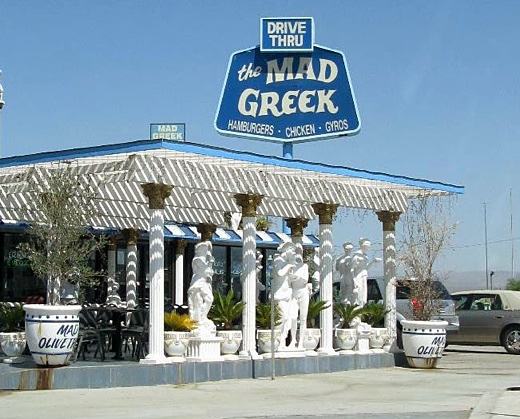 a
signifying dish,
though one totally unknown back in Ireland. The
Greeks created an entire diner
industry of which there was no trace back in
Greece. For so many immigrants, entering
into the United States’ welcoming food markets was
easy access to the American
Dream.
a
signifying dish,
though one totally unknown back in Ireland. The
Greeks created an entire diner
industry of which there was no trace back in
Greece. For so many immigrants, entering
into the United States’ welcoming food markets was
easy access to the American
Dream.
American food culture was
give-and-take, making
do, diversifying, modifying, and expanding, all
the while maintaining a revered
connection to the way it was done back in the old
country. There was no such
thing as “soul food” back in Africa, but here it
was full of rice and beans,
fried chicken and collards, pork chops and sweet
potato pie, developing the
name soul food in the 1960s as a part of ethnic
pride in African-American
culture. The
French never ate
potatoes or ever saw a French-fried potato until
the early 19th century, but
love of the spud was ubiquitous in America.
Italians could open an
Italian-American menu and not recognize dishes
with names like veal parmigiana,
chicken tetrazzini, fettuccine Alfredo, chicken
Vesuvius, hero sandwiches or
Italian cheesecake, much less ever go to a New
York-style Italian steakhouse
that served huge baked potatoes, shrimp cocktail
and five-pound Maine lobsters.
No resident of Tokyo or Osaka had 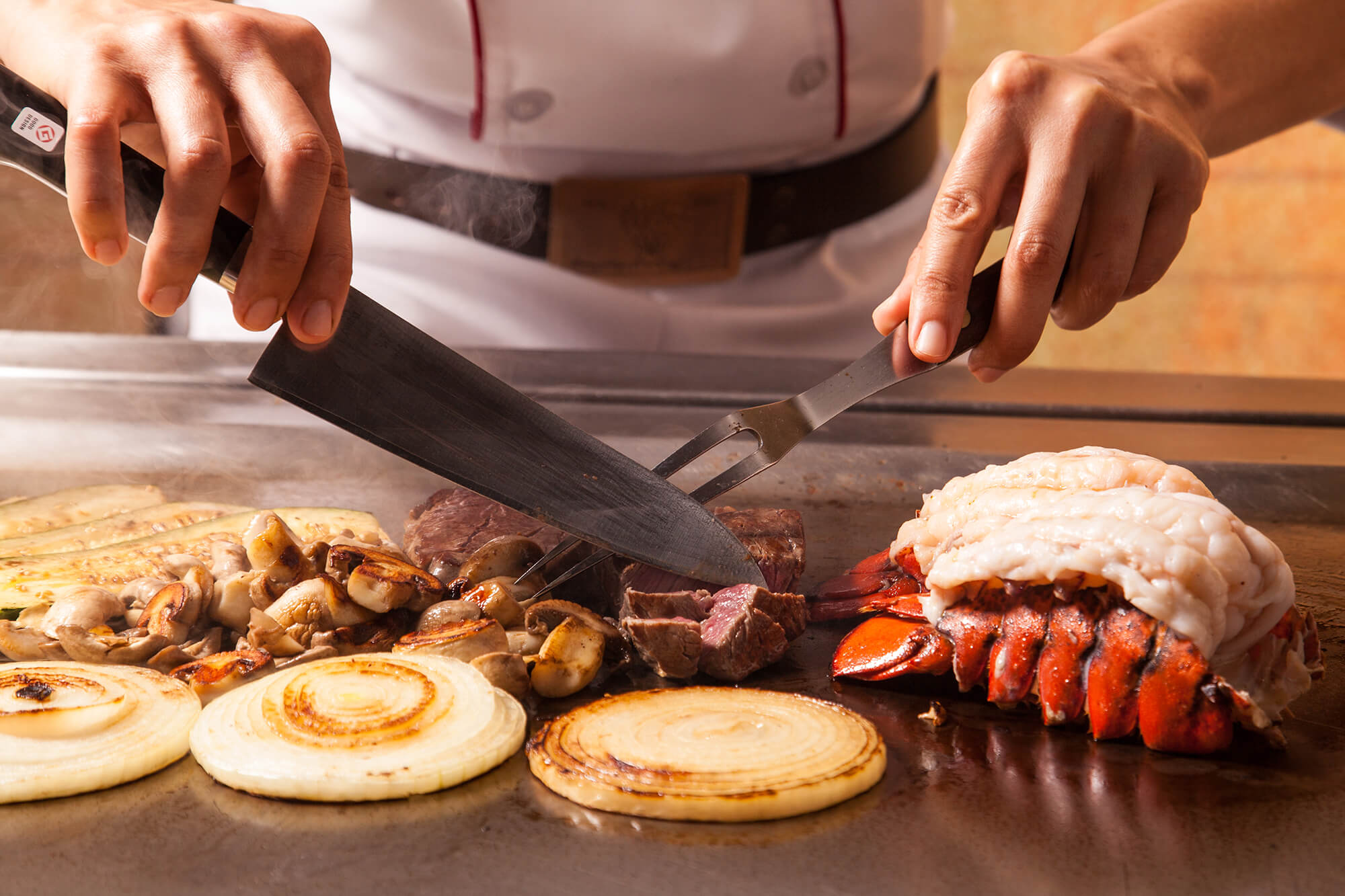 ever heard of negimaki
or California rolls.
And certainly no Mayan or Aztec had any concept of
what chili con carne,
chimichangas or fajitas could possibly be.
ever heard of negimaki
or California rolls.
And certainly no Mayan or Aztec had any concept of
what chili con carne,
chimichangas or fajitas could possibly be.
American
restaurants have a history of
adaption—curry houses, chop suey parlors,
pizzerias, rathskellers, Irish
bars, delicatessens, cafeterias and chili parlors
were all American adaptions
by immigrants who may never have eaten at a
restaurant back in the old country.
The pizza, which originated in Naples in the 17th
century, became far better
known and widely sold in America by 1950 than it
was in Italy until the 1980s,
and the Japanese imported the idea of Benihana of
Tokyo teppanyaki grills,
renaming them Benihana of New York (left).
The tiki bar (below), as
envisioned by “Trader Vic”
Bergeron in Oakland, offered a vast menu of dishes
completely made up to sound
like they came from Polynesia, like crab Rangoon,
bongo bongo soup, and the Mai
Tai cocktail. A Greek immigrant named Thomas
Andreas 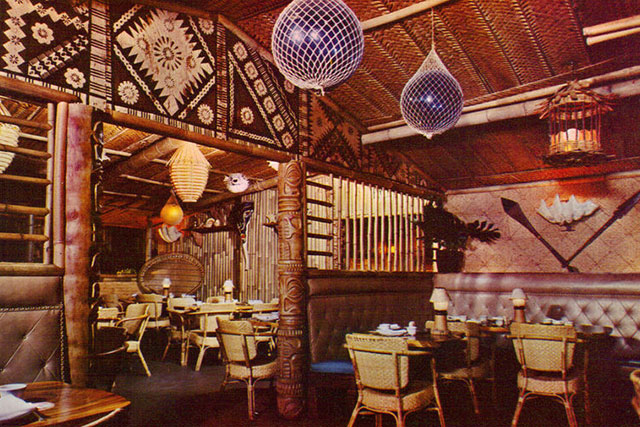 Carvelas perfected soft
ice cream and called it Carvel. The remarkable
first Horn & Hardart
Automat, constructed using German machinery,
opened in Philadelphia in 1902.
Yogurt was popularized in the1940s by Barcelona
immigrant Daniel Carasso, who
created the Dannon brand, later adding fruit
preserves to create the first
“sundae-style yogurt.”
Carvelas perfected soft
ice cream and called it Carvel. The remarkable
first Horn & Hardart
Automat, constructed using German machinery,
opened in Philadelphia in 1902.
Yogurt was popularized in the1940s by Barcelona
immigrant Daniel Carasso, who
created the Dannon brand, later adding fruit
preserves to create the first
“sundae-style yogurt.”
Drive-ins, soda fountains,
fast-food chains,
pancake houses, fish camps, ice cream parlors and
barbecue joints lined the
American highways, many of them done up in the
shape of the food they served,
like White Castle in Wichita, Randy’s Donuts and
Tale o’ the Pup, both in Los
Angeles.

Then, in
1939, the exhibitors at the New York
World’s Fair (left)
showcased the kind of cuisine that was more like
what was actually
being eaten in France, Italy, Czechoslovakia,
Formosa, and other countries.
None was so influential as the Fair’s French
Pavilion restaurant, later
recreated as Le Pavillon in New York by French
immigrant Henri Soulé, who set
the standard and template for what became
French-American haute cuisine. Its
menu of frogs’ legs Provençale, consommé
royale, pâté en crôute, and
chocolate mousse were
slavishly copied by all French restaurants to
follow, with names like La
Grenouille, La Caravelle and Le Périgord.
Still, after World War II, the
nation’s gastronomy
was in real danger of turning away from its
immigrant roots based on seasonal,
fresh 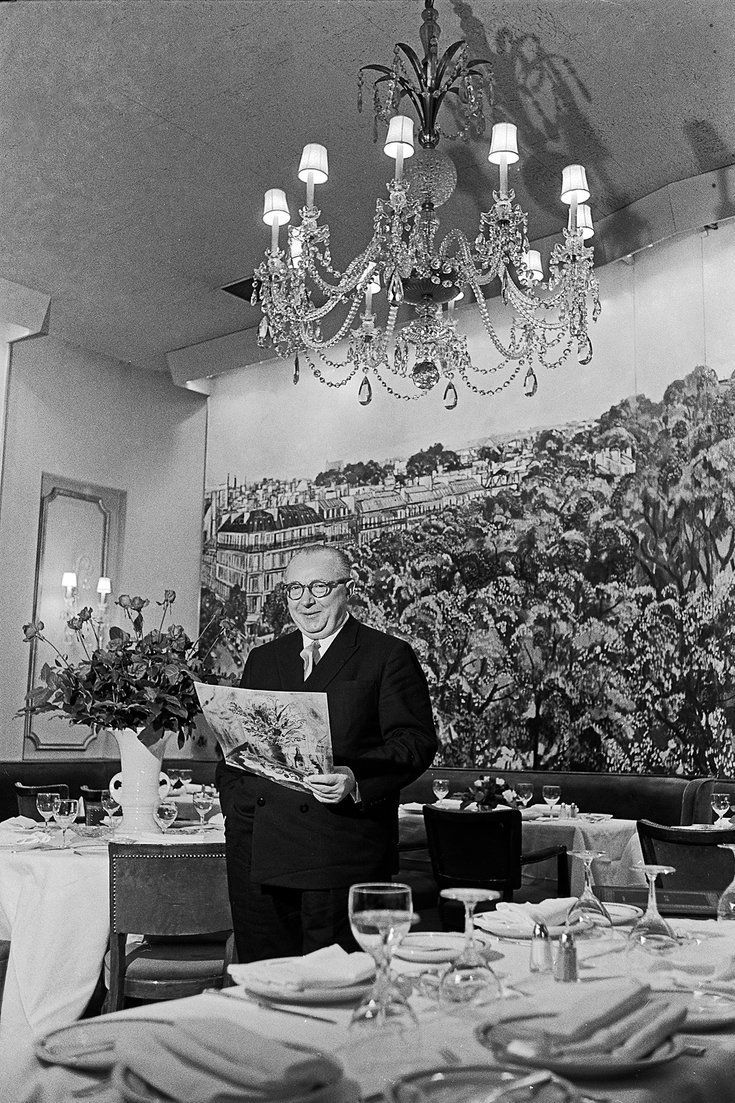 ingredients
and toward mere convenience and cost effectiveness
of frozen
and canned food, not to mention TV Dinners. As
Henri Soulé (right)
once moaned, “Some
of the richest people on Earth will dine here
tonight [at Le Pavillon]. And for
all the money on Earth, I couldn’t give them the
simple good things that every
middle-class Frenchman can afford from time to
time. Six Marennes oysters. A
partridge—very, very young. Some real primeurs—the
first
spring vegetables. A piece of Brie that is just
right. ... And some fraises des
Bois.”
ingredients
and toward mere convenience and cost effectiveness
of frozen
and canned food, not to mention TV Dinners. As
Henri Soulé (right)
once moaned, “Some
of the richest people on Earth will dine here
tonight [at Le Pavillon]. And for
all the money on Earth, I couldn’t give them the
simple good things that every
middle-class Frenchman can afford from time to
time. Six Marennes oysters. A
partridge—very, very young. Some real primeurs—the
first
spring vegetables. A piece of Brie that is just
right. ... And some fraises des
Bois.”
Yet by the 1970s, new waves of
immigrants,
especially from Asia, brought more and more new
foods, many of which were soon
planted in American farms. Overnight delivery by
FedEx and DHL from everywhere
made a cornucopia of wild mushrooms, fresh
seafood, cheeses and extra virgin
olive oil.
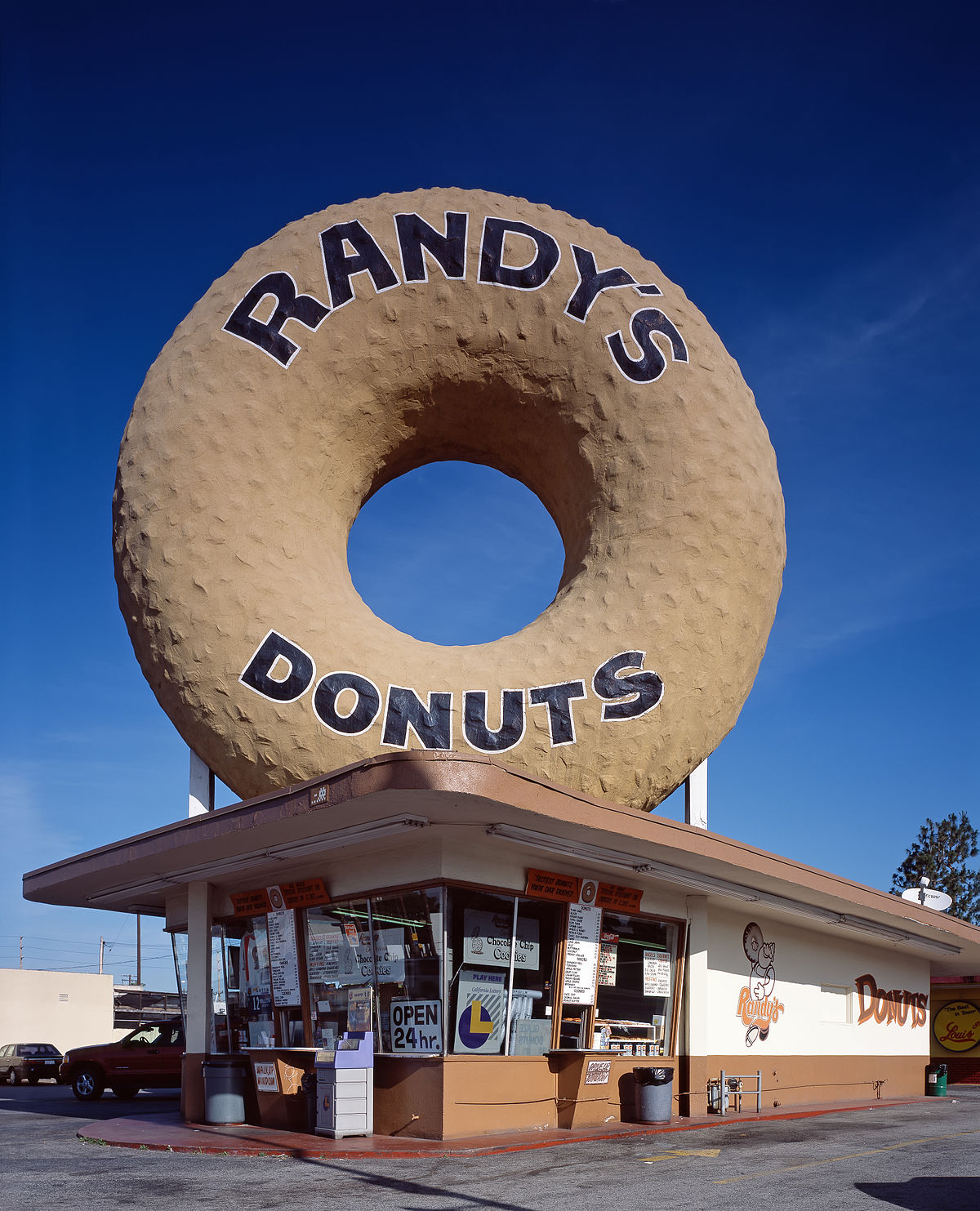 A little book that
became a bestseller, Diet for a
Small Planet by Frances Moore
Lappé (1971), and the pronouncements about the
healthfulness of the so-called
Mediterranean Diet that stressed eating
vegetables, grains and oils over
proteins and carbohydrates had an enormous effect
on the post-war baby boomers,
who were soon relishing the “ethnic” foods of
their own ancestors, leading to
more interest and hunger for “real” Italian food,
“real” Greek food, “real”
Spanish food, rather than the hybrid cuisines they
had grown used to since the
1950s.
A little book that
became a bestseller, Diet for a
Small Planet by Frances Moore
Lappé (1971), and the pronouncements about the
healthfulness of the so-called
Mediterranean Diet that stressed eating
vegetables, grains and oils over
proteins and carbohydrates had an enormous effect
on the post-war baby boomers,
who were soon relishing the “ethnic” foods of
their own ancestors, leading to
more interest and hunger for “real” Italian food,
“real” Greek food, “real”
Spanish food, rather than the hybrid cuisines they
had grown used to since the
1950s.
As
a result of more than 400 years of immigrant
history, America has not just the richest
gastronomy in the world—one that
ravenously accepts from other food cultures while
influencing them in
return—but one in which all those who accepted the
challenge to come here
contributed to and enjoyed. With all of them—from
the seafarers of Alaska and
the slaves of the South, the wheat-growing Swedes
of the Plains and the
Vietnamese boat people of Seattle, the
cannoli-makers and pastrami-briners, the
folders of phyllo and the smokers of trout, the
pretzel twisters and the tortilla
patters, every one of them has contributed to our
vast and delectable potluck
of so many wonderful things.
By John Mariani
LOVE AND PIZZA
Since, for the time being, I am unable to write about or review New York City restaurants, I have decided instead to print a serialized version of my (unpublished) novel Love and Pizza, which takes place in New York and Italy and involves a young, beautiful Bronx woman named Nicola Santini from an Italian family impassioned about food. As the story goes on, Nicola, who is a student at Columbia University, struggles to maintain her roots while seeing a future that could lead her far from them—a future that involves a career and a love affair that would change her life forever. So, while New York’s restaurants remain closed, I will run a chapter of the Love and Pizza each week until the crisis is over. Afterwards I shall be offering the entire book digitally. I hope you like the idea and even more that you will love Nicola, her family and her friends. I’d love to know what you think. Contact me at loveandpizza123@gmail.com
—John Mariani
Cover Art By Galina Dargery
 At
Columbia Nicola had no such problem with the
male students, who
either seemed to come from privileged
backgrounds and cared very little about
their course work or were quite the opposite,
burying themselves in their work
and competing very intensely, sometimes openly
nasty to their fellow
students.
Nor was Nicola
particularly interested in jocks, especially
at Columbia, whose sports teams
had deplorable records.
At
Columbia Nicola had no such problem with the
male students, who
either seemed to come from privileged
backgrounds and cared very little about
their course work or were quite the opposite,
burying themselves in their work
and competing very intensely, sometimes openly
nasty to their fellow
students.
Nor was Nicola
particularly interested in jocks, especially
at Columbia, whose sports teams
had deplorable records.
Nicola did have a momentary crush on one
professor, a lecturer in Psychology who had
a Dutch name so difficult to pronounce that he
asked his students to “just call
me Diercks.”
But he turned out to be such a dullard in
class that she saw no point in pursuing
him. And then there was
her professor of the History of Modern Art,
whose own name, Rhys St. John, she
found strangely charming, because she never
heard of anyone outside of an
English drawing room comedy with such a name. At first she was
embarrassed by not knowing whether Rhys was
pronounced “Reese” or “Rice,” and it was
attached to a last name that in the
first day of class he pronounced as “Sin Gin,” a
sound so exotic to Nicola that
he might as well have been from Sumatra. But he
definitely was not. “Reese Sin Gin” was half
Welsh, half
Irish, a mongrel mix evident in the red-gold
cast of his carefully mussed long
hair, which he constantly brushed from his brow
and around his ears in the
presence of his female students.
At six-foot-one, he towered over most of
them, but since Nicola was
herself five-foot-nine, the playing field was
not quite so tilted in his favor
as with other women students.
St. John, who apparently owned just two,
very similar brown tweed
jackets, had a habit of lecturing with a
cigarette in his fingers that he never
actually smoked, carefully wafting the smoke in
the air like filigree and very
slightly tapping the ash into a small aluminum
foil tray on his desk. He’d bring the cigarette
close to his
lips, then pause to say something he believed
was brilliant as he let his eyes
focus on one of the women students.
Quite often that was Nicola.
At
the end of each lecture St. John would put out
the cigarette, which he’d probably
bummed from a male student, and finish what he
was saying in a low tone of
voice, “ ... and after that, van
Gogh”—pronounced like he was clearing his
throat of phlegm, “van GOCK”—“put
down
his ragged paint brush ... and shot himself
through his own sad
heart.” Then
St. John would very
gently close the book he had lying open
throughout the class, even though he’d
never read a word from it, and he’d sniff and
mutter, “hm.”
It did not take Nicola long
to
recognize that St. John’s hand movements,
curlicues of smoke, and modulated
speech were all part of a pattern, one that was
in many ways effective in
teaching his subject; he kept his students awake
most of the time and even
imparted some thoughtful ideas for their
consideration.
But she also knew that the act was
aimed squarely at the women in his classes and
St. John’s reputation for
philandering made for widespread gossip, much of
it true. One
time he came to class with a
chipped tooth, daring not to glance at a female
student whose ring finger was
bandaged that day.
The first
time Nicola met with St.
John in his office to go over what he expected
of her in the coming semester,
she had applied some lipstick before entering.
Getting up from his leather
swivel chair and rising to his full height, his
first words were, “Well, I must
say you women students get lovelier each year,”
delivered with a lilting,
burring brogue.
“Come in, come in,
sit down, Miss--?”
“Santini, Nicola Santini,”
she
said, smiling slightly.
“Well, you're as pretty as
your name,
Miss Santini. Sit down, sit down.
So let’s talk about the coming semester,
what I expect of you, and, of
course, what your own interests might be.”
Nicola momentarily wanted to
be
taken in by St. John’s charms but she was savvy
enough to know they were well
practiced, so she dove right in to discuss what
her interests were, ignoring
for the moment her professor’s.
“I’m most interested in
Italian
Renaissance art,” she began.
“Isn't everyone?” he
interrupted
with a light laugh.
Nicola plowed on: “So, while
I
want to know as much as possible about all the
visual arts, I think that’s
going to be my focus, especially the Venetian
painters.”
“Tintoretto, Titian,
Veronese.”
“Yes,” she said. “I
don’t think I have any particular
talent for painting myself, but I believe I
would make a good teacher.”
“At the college level?”
“Absolutely.”
“So you’re aiming to go to
grad
school in Art History?”
Nicola smiled and turned her
head.
“Yes, if I can afford it. It’s gotten very
expensive.”
St. John patted his tweed
jacket
pockets. “Hm, you don’t happen to have a
cigarette, do you?”
“Don’t smoke,” she answered.
“Well, no matter. Now,
about grad school, since I haven’t
had you in class for very long, I don’t know how
good a student you are, but I
have heard some of the other
professors speak highly of you.”
Nicola widened her eyes and
said,
“Really? They’ve spoken to you about me? I know
so few of them.”
“Well, let’s say I might have
asked about you.
I’ve seen you
around campus and here in the halls.”
At this Nicola relaxed her
shoulders, sensing that St. John’s interest was
increasingly non-academic in
nature. But
she told herself
simply to stay cool and not to encourage him in
any way.
“So what do you expect from me?”
she asked.
“Oh, not that much. This is a
pretty basic course, and I try to cover a lot of
material.
So if you do the readings and a decent
five-to-seven-page paper, you should do fine. I do like students who
show real interest, though. I
swear some of these people sit in
class with their eyes half closed throughout the
whole semester, never asking a
question, seemingly terrified I might ask them
one. They cut more classes than
they attend.” Then, putting his hand very
lightly on Nicola’s forearm, he said,
“May I confide in you?”
Nicola said nothing. He said,
“I
have certainly noticed that you do
not fall into that crowd. I think you’ve asked
some very good questions in
class and, if I’m not mistaken, you’ve never cut
a class.”
Nicola shook her head and
said,
“Not when my parents and I are paying for this.”
The word “parents” drew St.
John
up and he said, “Of course, of course.
I wish more students had that attitude.
Too many of them are just trust
fund babies whose parents pay for every dime of
their education, so they just
don’t really care. Most of them take my course
just to fulfill a curriculum
requirement.”
Now Nicola thought it best to
lay
it on the line: “I care very much. I don’t come
from a rich family and I don't
live in a rich community. I’m a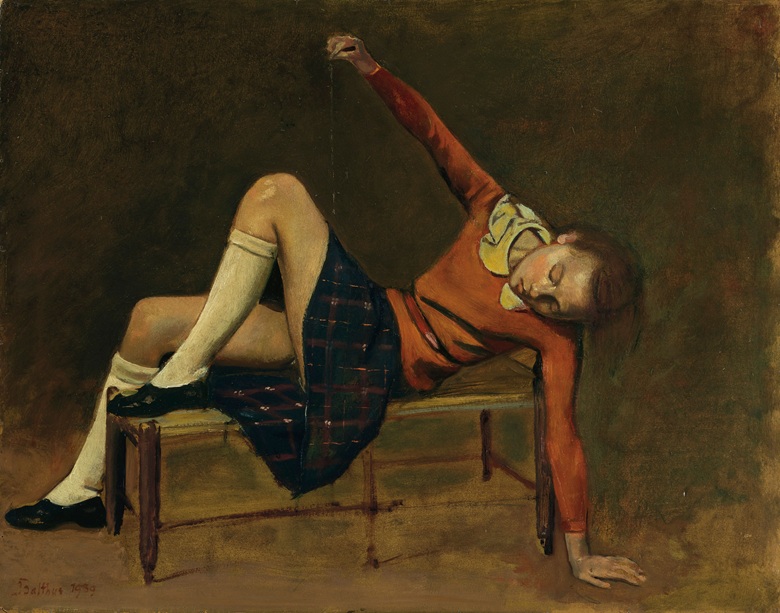 Bronx girl and I’m proud of it, so I never take
what my parents have done for
me for granted.
I also don’t know
if, assuming I do go to grad school and
eventually teach, I will ever be able
to repay them in every way I’d like to.
I know what my grandparents did, coming
to this country with very little
and making sure their children and my brothers
and sisters got the best
education possible. Columbia is a
real stretch for a family like mine, and I never
forget that for a minute.”
Bronx girl and I’m proud of it, so I never take
what my parents have done for
me for granted.
I also don’t know
if, assuming I do go to grad school and
eventually teach, I will ever be able
to repay them in every way I’d like to.
I know what my grandparents did, coming
to this country with very little
and making sure their children and my brothers
and sisters got the best
education possible. Columbia is a
real stretch for a family like mine, and I never
forget that for a minute.”
“That is so
terrific,” said St. John, “Christ, if
I only had more students like you, my job would
be a lot easier and much more
rewarding.” Then he paused, looked Nicola up and
down, leaned over and put his
hand again on her arm, almost whispering, “So
... you’re not just smart and
beautiful but you’ve got a real moral
compass, too. Amazing. And very rare.”
"Thérèse sur un Banquette" (1932) by Balthus
Nicola kept
herself from saying
something stupid like “I bet you say that to all
the girls” because she knew he
had a practiced retort for something like that.
Instead, she said, “Well, thank
you. I hope I live up to your faith in me.”
St. John almost bowed. “And I
in
yours,” which he realized sounded like bad
grammar, even slightly creepy. He
stood up and said, “So, then, see
you in class Thursday.”
Nicola said yes, smiled and
left,
noticing that as she walked away St. John had
arched his head to watch
her. Nicola
muttered to herself,
“Christ, this man is
trouble,” and
wiped her lipstick off on the back of her hand,
as if she’d just been kissed by
a drunkard. She then went to the library to read
St. John’s next assignment, a
book on the painter Balthus.
❖❖❖
FINEST WINES FOR TAKE-OUT
By
John Mariani
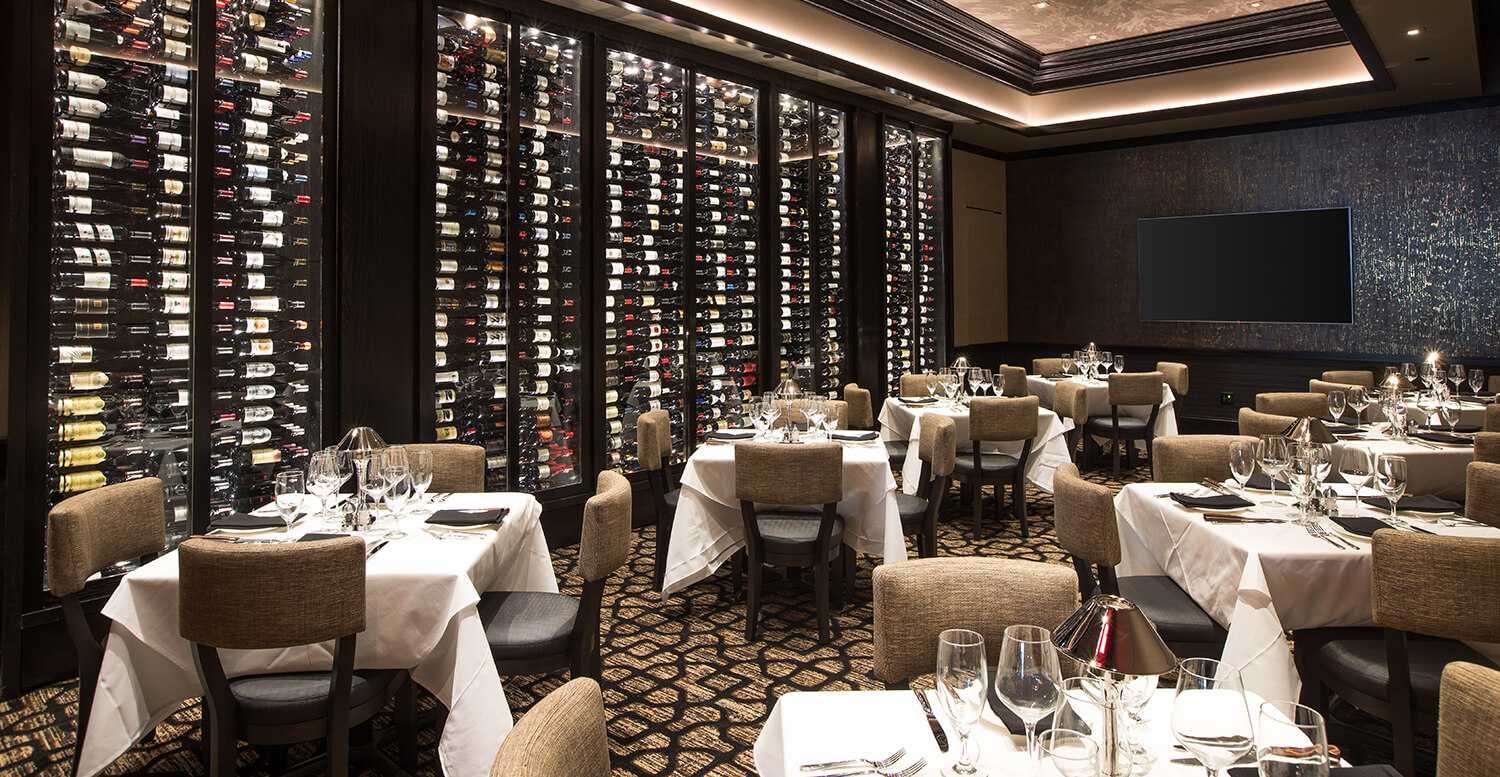
The Wine Wall at Mastro's in the Post Oak Hotel in Houston, TX
One of the ironies of the
current pandemic is
that you may now be able to enjoy your favorite
meals from fine dining
restaurants as well as drink discounted
prestigious wines from their list.
In an industry with small profit
margins to
begin with, and a significant percentage of those
profits coming from wine and
spirits sales, restaurateurs are scrambling with new
business models to keep
them afloat during the coronavirus pandemic. And
those that have managed to
stay open by offering take-out and delivery service
have found that their
customers may have as good an appetite for fine
wines as they did on premises.
Sauvage
restaurant in Brooklyn has turned its
website into an on-line wine shop, with most bottles
costing $20-$30, and June
Wine Bar, also in Brooklyn, is selling selections at
50% off.
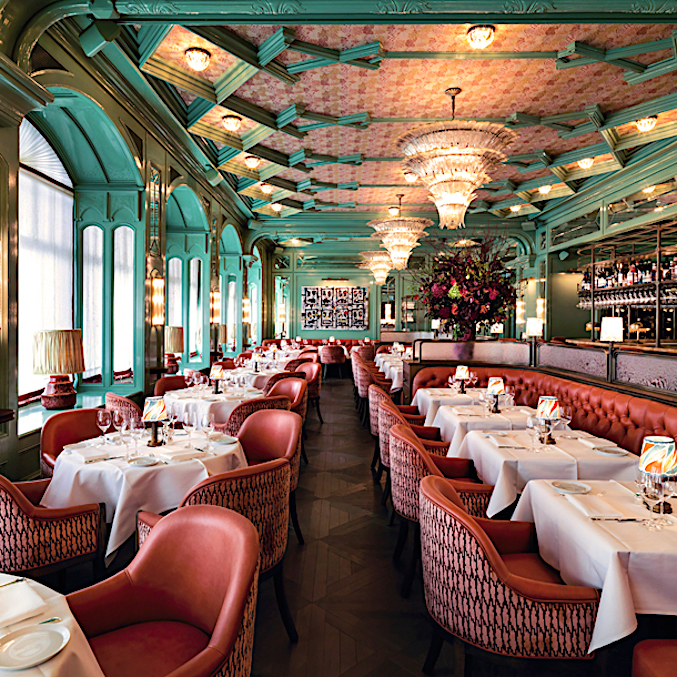 Such offers are really
rather drastic,
considering a restaurant may buy a bottle of wine
from a distributor for about
half the price you’d pay in a wine shop, then hike
up the price on the wine
list 100-300 percent.
Such offers are really
rather drastic,
considering a restaurant may buy a bottle of wine
from a distributor for about
half the price you’d pay in a wine shop, then hike
up the price on the wine
list 100-300 percent.
Even a few of the grand hotels of
Europe are
now offering take-out food and wine from their
classic menus for both in-house
guests and locals. The restaurants at the
176-year-old Baur
au Lac (left)
in Zurich,
Switzerland, are closed but you can order on-line
and have it delivered to your
home, including wines such as a Paladin Brut
Millisimata Brut Prosecco 2018 for
$17.60 and Saint-Saphorin Grand Cru “Les Blassinges”
from the Vaud region for
$19.65.
At
New York’s Michelin-starred Italian seafood
restaurant Marea, wines on their
reserve list are all 25% off, including prestigious
Italian labels like Alteni
de Brassica Sauvignon Blanc 2015 from Gaja, among
the most illustrious Italian
wine producers, which runs $350 on the regular list
but $262.50 for take-out.
At
the restaurants at the Post Oak Hotel in Houston, which
includes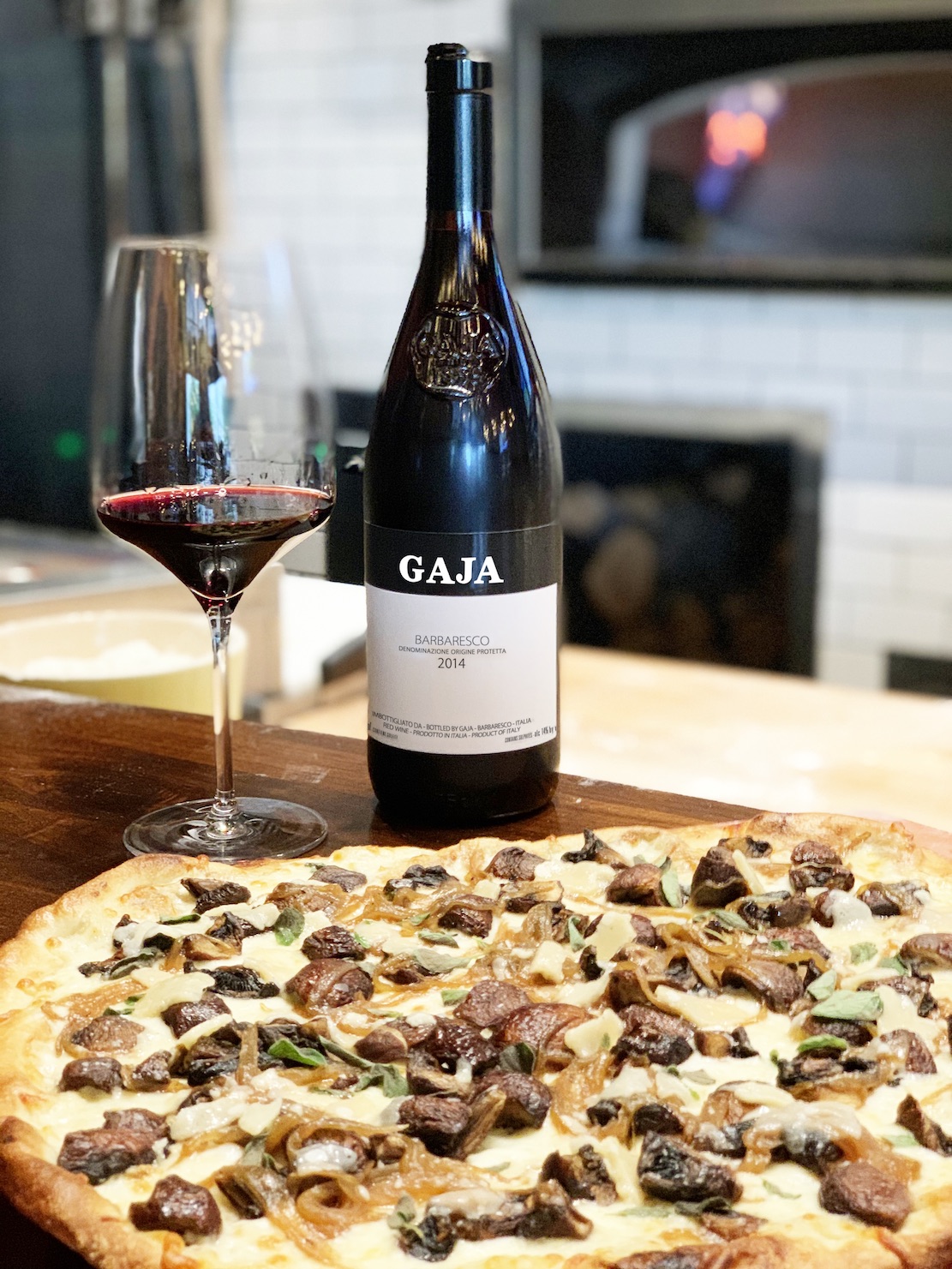 Mastro’s
Steakhouse, Keith Goldston, master sommelier of
parent company Landry’s Inc., is
even pairing Gaja wines with two pizza offerings: Ca'
Marcanda Promis 2016 with a pepperoni, marinara
and mozzarella pizza for $70, inclusive, and a 2014 Barbaresco
(right)
with a roasted mushroom,
white truffle oil and oregano pizza for $225.
“We’re also offering all 39
selections of Gaja wines at a 20-50% markdown from
the wine list price,”
Golston said.
Mastro’s
Steakhouse, Keith Goldston, master sommelier of
parent company Landry’s Inc., is
even pairing Gaja wines with two pizza offerings: Ca'
Marcanda Promis 2016 with a pepperoni, marinara
and mozzarella pizza for $70, inclusive, and a 2014 Barbaresco
(right)
with a roasted mushroom,
white truffle oil and oregano pizza for $225.
“We’re also offering all 39
selections of Gaja wines at a 20-50% markdown from
the wine list price,”
Golston said.
 According to Gaia Gaja (left), fifth
generation of the family that owns the company, “In
these difficult
times fine dining and fine wines are surely a
luxury, but they can also be
a source of support for people confined at
home. A take-out of a fine meal
and wine is a way to bring home a taste of normalcy
and hope. I think it’s a
great service to people. We are seeing some
restaurants in Italy doing this
too,” citing San Lorenzo restaurant and Pierluigi
restaurant in Rome and Ribot
in Milan.
According to Gaia Gaja (left), fifth
generation of the family that owns the company, “In
these difficult
times fine dining and fine wines are surely a
luxury, but they can also be
a source of support for people confined at
home. A take-out of a fine meal
and wine is a way to bring home a taste of normalcy
and hope. I think it’s a
great service to people. We are seeing some
restaurants in Italy doing this
too,” citing San Lorenzo restaurant and Pierluigi
restaurant in Rome and Ribot
in Milan.
At
Wolfgang Puck’s Spago
(right) in
Beverly Hills,
which has always had a strong celebrity and show
business clientele, wine sales
have 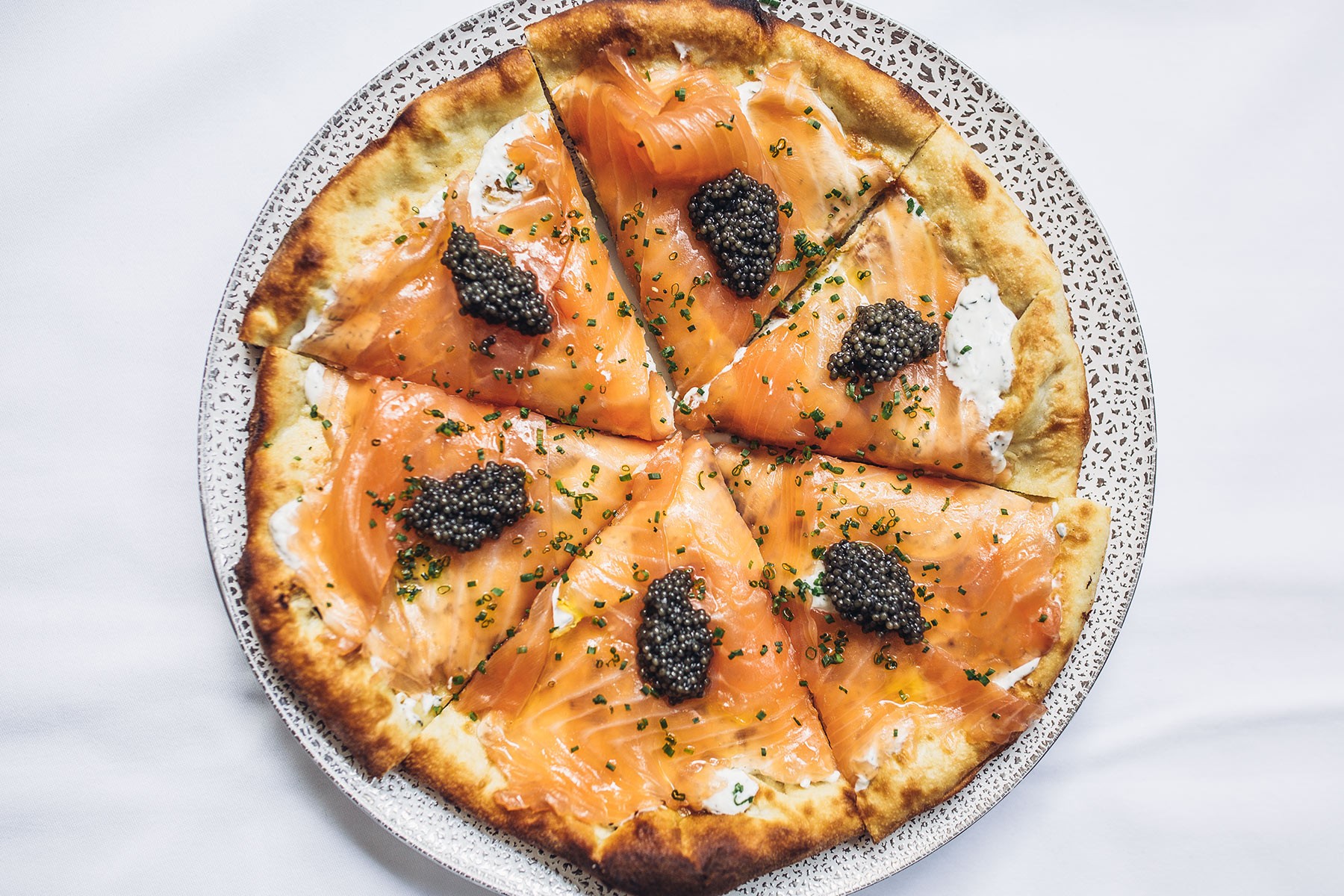 been both at the value end
and the high end, now discounted. “We have an offering that
ranges from $18 to $650 and now
most wines we are selling are between $25 and
$100,” says Philip Dunn, Spago’s
Director of Wine and Spirits/Sommelier. “Our
prices for the most part are
better or at least the same as most off-premise
retailers. We have
surprisingly sold a fair amount of
Champagne, Ruinart Rosé, Dom Pérignon,
vintage Krug, Deutz and Laurent Perrier as well as
Moët & Chandon mini
bottles. Others that do well are Gaja in
half-bottle, Groth Reserve
Cabernet Sauvignon, Jordan Cabernet Sauvignon and
Pichler & Puck Grüner
Veltliner. Our offerings change as we
run low on stock.”
been both at the value end
and the high end, now discounted. “We have an offering that
ranges from $18 to $650 and now
most wines we are selling are between $25 and
$100,” says Philip Dunn, Spago’s
Director of Wine and Spirits/Sommelier. “Our
prices for the most part are
better or at least the same as most off-premise
retailers. We have
surprisingly sold a fair amount of
Champagne, Ruinart Rosé, Dom Pérignon,
vintage Krug, Deutz and Laurent Perrier as well as
Moët & Chandon mini
bottles. Others that do well are Gaja in
half-bottle, Groth Reserve
Cabernet Sauvignon, Jordan Cabernet Sauvignon and
Pichler & Puck Grüner
Veltliner. Our offerings change as we
run low on stock.”
At the restaurants within
the Post Oak Hotel, Goldston says, “We are seeing a
little bit of value
shopping, but most of our guests are ordering their
usual favorites and we are
even seeing a slight uptick in ‘trophy wine’ sales
as some are seeing this as
an opportunity to drink great wines—‘if not now,
then when?’” Puck's famous salmon and caviar pizza (above) is part
of their take-out program.
Asked
if wine sales through
take-out have been a good income producer at a time
the restaurants are closed,
Goldston said, “Absolutely, and they are especially
appreciated as they are a
revenue stream that doesn't require a lot of labor.”
Sponsored By

Any of John Mariani's books below may be ordered from amazon.com.
 The Hound in Heaven
(21st Century Lion Books) is a novella, and
for anyone who loves dogs, Christmas, romance,
inspiration, even the supernatural, I hope you'll find
this to be a treasured favorite. The story
concerns how, after a New England teacher, his wife and
their two daughters adopt a stray puppy found in their
barn in northern Maine, their lives seem full of promise.
But when tragedy strikes, their wonderful dog Lazarus and
the spirit of Christmas are the only things that may bring
his master back from the edge of despair.
The Hound in Heaven
(21st Century Lion Books) is a novella, and
for anyone who loves dogs, Christmas, romance,
inspiration, even the supernatural, I hope you'll find
this to be a treasured favorite. The story
concerns how, after a New England teacher, his wife and
their two daughters adopt a stray puppy found in their
barn in northern Maine, their lives seem full of promise.
But when tragedy strikes, their wonderful dog Lazarus and
the spirit of Christmas are the only things that may bring
his master back from the edge of despair. WATCH THE VIDEO!
“What a huge surprise turn this story took! I was completely stunned! I truly enjoyed this book and its message.” – Actress Ali MacGraw
“He had me at Page One. The amount of heart, human insight, soul searching, and deft literary strength that John Mariani pours into this airtight novella is vertigo-inducing. Perhaps ‘wow’ would be the best comment.” – James Dalessandro, author of Bohemian Heart and 1906.
“John Mariani’s Hound in Heaven starts with a well-painted portrayal of an American family, along with the requisite dog. A surprise event flips the action of the novel and captures us for a voyage leading to a hopeful and heart-warming message. A page turning, one sitting read, it’s the perfect antidote for the winter and promotion of holiday celebration.” – Ann Pearlman, author of The Christmas Cookie Club and A Gift for my Sister.
“John Mariani’s concise, achingly beautiful novella pulls a literary rabbit out of a hat – a mash-up of the cosmic and the intimate, the tragic and the heart-warming – a Christmas tale for all ages, and all faiths. Read it to your children, read it to yourself… but read it. Early and often. Highly recommended.” – Jay Bonansinga, New York Times bestselling author of Pinkerton’s War, The Sinking of The Eastland, and The Walking Dead: The Road To Woodbury.
“Amazing things happen when you open your heart to an animal. The Hound in Heaven delivers a powerful story of healing that is forged in the spiritual relationship between a man and his best friend. The book brings a message of hope that can enrich our images of family, love, and loss.” – Dr. Barbara Royal, author of The Royal Treatment.
 |
The Encyclopedia of American Food and Drink by John F. Mariani (Bloomsbury USA, $35) Modesty forbids me to praise my own new book, but let me proudly say that it is an extensive revision of the 4th edition that appeared more than a decade ago, before locavores, molecular cuisine, modernist cuisine, the Food Network and so much more, now included. Word origins have been completely updated, as have per capita consumption and production stats. Most important, for the first time since publication in the 1980s, the book includes more than 100 biographies of Americans who have changed the way we cook, eat and drink -- from Fannie Farmer and Julia Child to Robert Mondavi and Thomas Keller. "This book is amazing! It has entries for everything from `abalone' to `zwieback,' plus more than 500 recipes for classic American dishes and drinks."--Devra First, The Boston Globe. "Much needed in any kitchen library."--Bon Appetit. |
"Eating Italian will never be the same after reading John Mariani's entertaining and savory gastronomical history of the cuisine of Italy and how it won over appetites worldwide. . . . This book is such a tasteful narrative that it will literally make you hungry for Italian food and arouse your appetite for gastronomical history."--Don Oldenburg, USA Today. "Italian
restaurants--some good, some glitzy--far
outnumber their French rivals. Many of
these establishments are zestfully described
in How Italian Food Conquered the World, an
entertaining and fact-filled chronicle by
food-and-wine correspondent John F.
Mariani."--Aram Bakshian Jr., Wall Street
Journal.
"Equal parts
history, sociology, gastronomy, and just
plain fun, How Italian Food Conquered the
World tells the captivating and delicious
story of the (let's face it) everybody's
favorite cuisine with clarity, verve and
more than one surprise."--Colman Andrews,
editorial director of The Daily
Meal.com. "A fantastic and fascinating
read, covering everything from the influence
of Venice's spice trade to the impact of
Italian immigrants in America and the
evolution of alta cucina. This book will
serve as a terrific resource to anyone
interested in the real story of Italian
food."--Mary Ann Esposito, host of PBS-TV's
Ciao
Italia. "John Mariani has written the
definitive history of how Italians won their
way into our hearts, minds, and
stomachs. It's a story of pleasure over
pomp and taste over technique."--Danny Meyer,
owner of NYC restaurants Union Square
Cafe, The Modern, and Maialino.
|
 |
 |
 |
 |
 |
 |
 |
 |
 Everett Potter's Travel Report:
Everett Potter's Travel Report: 
 Eating Las Vegas
JOHN CURTAS has been covering the Las Vegas
food and restaurant scene since 1995. He is
the co-author of EATING LAS VEGAS – The 50
Essential Restaurants (as well as
the author of the Eating Las Vegas web site: www.eatinglasvegas.
He can also be seen every Friday morning as
the “resident foodie” for Wake Up With the
Wagners on KSNV TV (NBC) Channel 3 in
Las Vegas.
Eating Las Vegas
JOHN CURTAS has been covering the Las Vegas
food and restaurant scene since 1995. He is
the co-author of EATING LAS VEGAS – The 50
Essential Restaurants (as well as
the author of the Eating Las Vegas web site: www.eatinglasvegas.
He can also be seen every Friday morning as
the “resident foodie” for Wake Up With the
Wagners on KSNV TV (NBC) Channel 3 in
Las Vegas.
MARIANI'S VIRTUAL GOURMET
NEWSLETTER is published weekly. Publisher: John Mariani. Editor: Walter Bagley. Contributing Writers: Christopher Mariani,
Robert Mariani, Misha Mariani, John A. Curtas, Gerry Dawes, Geoff Kalish,
and Brian Freedman. Contributing
Photographer: Galina Dargery. Technical
Advisor: Gerry
McLoughlin.
If you wish to subscribe to this
newsletter, please click here: http://www.johnmariani.com/subscribe/index.html
© copyright John Mariani 2020
